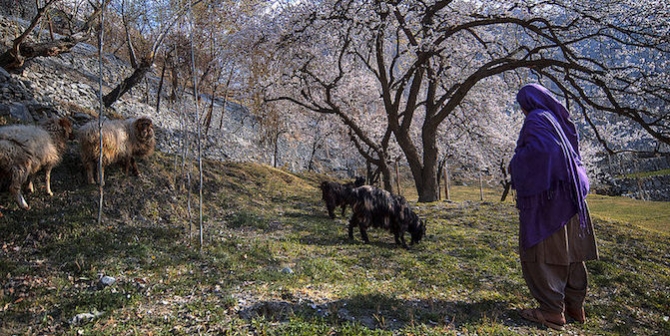Far from signifying the end of caste-based politics, Narendra Modi’s victory in May’s general election has reinvented and redefined caste-based politics, according to Avishek Jha (Independent Researcher). Here he argues why the BJP’s victory must be attributed to its social coalitions and the political mobilisation of less dominant castes and sub-castes not just its use of national security issues.
The mammoth victory of Narendra Modi and the Bharatiya Janata Party (BJP) has spelt doom for the caste-based parties of India’s heartland, primarily Uttar Pradesh’s Samajwadi Party and the Bahujan Samaj Party, and Bihar’s Rashtriya Janata Dal who have shaped Indian politics over the last three decades.
The all-consuming nationalistic campaign of the BJP, led by its most popular leader, Narendra Modi, trumped the caste orientations and political arithmetic of the Hindi heartland, helping the BJP to retain its supremacy in two of the most crucial states, accounting for 120 seats in the national parliament. The BJP-led National Democratic Alliance won 64 out of the 80 seats in Uttar Pradesh against the powerful coalition of the Samajwadi Party and Bahujan Samaj Party, and 39 out of the 40 seats in Bihar against the United Progressive Alliance’s rainbow coalition, comprising of nearly 29% of the NDA’s total seat share in the Lok Sabha.
Naturally, questions have been raised over the future of India’s caste-based parties and the sustainability of their ‘politics of identity’ against the twin onslaught of aspirational politics and religious nationalism, largely personified by Narendra Modi. Does the BJP juggernaut underline the end of caste-based politics and mobilisation in the name of social justice? Has the politics of the saffron BJP with its ideals of Hindutva completely defeated post-Mandal politics and its social justice legatees in India’s politically most significant states? Is the future of such political parties that mobilise their supporters along markers of caste identity in India’s modified political cartography bleak?
A closer analysis of the electoral victory of the BJP paints a different picture. While it is true that the BJP-RSS machinery led by Prime Minister Modi has redefined India’s political consensus with a growing inclination towards aspirational, religious nationalism and support for strong leadership under Modi, the age-old tropes of political mobilisation like caste are still alive. The election results highlight a crucial trend in the BJP’s brand of politics in successive parliamentary elections in 2014 and 2019 and the assembly elections of Uttar Pradesh in 2017.
In the 1990s, the BJP, touted to be a party of upper castes, embarked on a process of uplifting backward caste leaders in the party such as Kalyan Singh in Uttar Pradesh, Uma Bharti in Madhya Pradesh and Narendra Modi in Gujarat among others. BJP ideologue K. Govindacharya defined this movement as BJP’s attempt at social engineering. In the second phase of BJPs phenomenal rise under Narendra Modi, the party’s social engineering experiment has hinged on the involvement of hitherto less dominant castes and sub-castes, thereby trumping the traditional practitioners of caste politics in India. According to Prof. Badri Narayan, the BJP’s strategy delves on the idea of ‘Samagra Hindutva’ which seeks to integrate OBCs and scheduled castes within the Hindutva fold.
Therefore, the BJP’s political success can be attributed to its resilience in carefully crafting social alliances by incorporating electorally significant castes and sub-castes in its modules of political representation and mobilisation, thereby garnering political mileage out of its uniquely created social capital. Moreover, the image makeover of Prime Minister Modi as a leader of the other backward classes and his evocation of the BJP as the party of the Other Backward Classes (OBCs) brought about a sea change in the BJP’s reach among different communities in the heartland. Most importantly, the BJP’s success lies in its ability to detect changing voter behaviour and discontent among the masses. The BJP successfully found itself a political space among the castes and subcastes unsatisfied with and abhorrent to the hegemony of the dominant intermediaries such as the Yadavs among the OBCs and Jatavs among the Dalits.
BJP’s caste calculus in Uttar Pradesh and Bihar
In Uttar Pradesh, the Samajwadi Party led by Akhilesh Yadav and the BahujanSamaj Party led by Mayawati forged an alliance prior to the Lok Sabha elections of 2019 to consolidate their core voter constituencies, represented by the Yadavs and Muslims and the Jatav Dalits respectively, to thwart the BJP juggernaut. The Rashtriya Lok Dal, significant among the Jats of western Uttar Pradesh, was also given space in the coalition. Simple caste calculus and poll arithmetic, based on the vote shares of the two regional heavyweights predicted massive numbers for the Mahagatbandhan (Grand Coalition).
While the BJP’s overarching narrative centred on a hyper-nationalistic discourse, the party was able to craft innumerable micro coalitions at the social level with perks of political representation to castes other than the politically dominant ones and the targeted distribution of the government’s welfare schemes. Therefore, apart from its core voter base among the upper castes, the BJP breached the non-Yadav vote bank among the Other Backward Classes—garnering significant support from communities like the Kurmis and Mauryas; from the Most Backward Castes, involving communities like the Nishads among others and most significantly the non-JatavDalits, thus nullifying Mayawati’s undisputed hold over the politics of the region. The BJP-RSS combine’s politics also included the appropriation of lower caste icons to widen the idea of Hindutva and unleash the second phase of social engineering since 2014.
Unlike Uttar Pradesh, where the opposition was disunited with the Congress fighting the elections on its own, in Bihar, the electoral contest was largely between two coalitions— the National Democratic Alliance, comprising of the BJP, Nitish Kumar’s Janata Dal (United) and the Lok Janashakti Party, and the United Progressive Alliance, comprising of the Rashtriya Janata Dal (RJD), the Congress party, Upendra Kushwaha’s Rashtriya Lok Samata Party, Jitan Ram Manjhi’s Hindustani AwamMorcha and Vikassheel Insan Party. The absence of the charismatic Laloo Prasad Yadav, whose politics of mobilizing Yadavs and Muslims worked wonders in the Bihar assembly polls in 2015 and arrested Narendra Modi’s victory parade, negatively affected the alliance’s poll prospects.
It should be noted that both coalitions developed envious caste coalitions with the UPA harbouring the leadership of parties traditionally strong among the Yadavs, the Kushwahas, the Mallahs, the Maha Dalits, the Nishads and the Muslims. On the other hand, the NDA constituents enjoyed support across the upper castes, the Kurmis among other non-Yadav OBCs, and the Dalits. Besides, Bihar chief minister Nitish Kumar’s introduction of a reserved category and government sponsored benefits helped in the consolidation of the most backward castes votes for the NDA. In spite of such strong coalitions, the UPA failed to defeat the Narendra Modi-led NDA which secured 53% of the total votes polled. The principle regional party in the opposition—the RJD— Laloo Prasad Yadav’s carrier of the politics of social justice in Bihar for nearly two decades garnered merely 15.4% votes while failing to win a single seat in the Lok Sabha elections. On the other hand, the popularity ratings of Narendra Modi at the centre and Nitish Kumar at the state level along with a handsome caste coalition trounced the opposition in Bihar. According to The Hindu-Lokniti CSDS post-poll survey, the Koeris, other non-Yadav OBCs and Dalits voted in favour of the NDA decisively despite the presence of backward caste leaders like UpendraKushwaha, Mukul Sahni and Jitan Ram Manjhi in the UPA.
Reinventing the politics of caste
Contrary to popular belief, far from signifying the end of caste-based politics, the victory of Narendra Modi in 2019 has reinvented and redefined caste and its political salience. Apart from the strong leader image of Narendra Modi and the use of national security as the central election issue, the BJP’s victory must be attributed to its social coalitions and the political mobilization of less dominant castes and sub-castes. The social churning set in motion with the idea of Samagra Hindutva defeated the strong Dalit-Bahujan alliance in Uttar Pradesh, which failed to transfer its core votes of Yadavs and Jatav Dalits to one another, and punctured the UPA’s campaign centered around the issue of reservation and welfare of the lower castes in Bihar. The proponents of caste-based politics, both in Uttar Pradesh and Bihar, were seen lagging due to their fixation with dynastic politics, with corruption and self-preservation defining their political identities. The BJPs victory reiterates the fact that identity-driven politics will retain its utility in a vast and diverse democracy like India. However, it is crucial for the traditional doyens of caste politics in India to reinvent themselves and recalibrate their ideologies to remain significant in the changing political discourse and resonate with the growing aspirations of its core voter constituencies.
This article gives the views of the author and not the position of South Asia @ LSE blog, nor of the London School of Economics. Please read our comments policy before posting. Featured image: Rectangular network ring | Credit: Pixabay, Geralt.
Avishek Jha is an independent researcher working on issues concerning Indian and South Asian politics. He is a Young India Fellow, Class of 2018, from Ashoka University. He has been a Programmes Fellow with the Academe India Foundation. He completed his Masters in Political Science & International Relations from the Department of International Relations, Jadavpur University, Kolkata.







